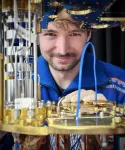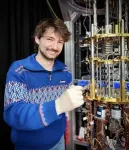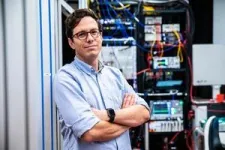(Press-News.org) Qubits—the fundamental units of quantum information—drive entire tech sectors. Among them, superconducting qubits could be instrumental in building a large-scale quantum computer, but they rely on electrical signals and are difficult to scale. In a breakthrough, a team of physicists at the Institute of Science and Technology Austria (ISTA) has achieved a fully optical readout of superconducting qubits, pushing the technology beyond its current limitations. Their findings were now published in Nature Physics.
Following a year-long rally, quantum computing stocks were brought to a standstill barely a few days into the International Year of Quantum Science and Technology. The reason for this sudden setback was Nvidia CEO Jensen Huang’s keynote at the CES 2025 tech trade show, where he predicted that “very useful quantum computers” were still two decades down the road.
Aside from stock markets and tech trade shows, the race continues fiercely toward scalable quantum computers that could perform some calculations exponentially faster than ‘classical’ computers. While this promising ‘quantum advantage’ resulted in the rapid development of quantum hardware, many technical hurdles must still be overcome before quantum computers become ‘useful’.
Now, a team of physicists from Professor Johannes Fink’s group at the Institute of Science and Technology Austria (ISTA) has managed to overcome an important limitation, which could help scale up quantum computers. By ensuring the qubits understand the language of fiber optics, the team considerably reduced the amount of cryogenic hardware needed to measure them. “This new approach might allow us to increase the number of qubits so they become useful for computation. It also lays the foundation for building a network of superconducting quantum computers connected via optical fibers at room temperature,” says co-first author Georg Arnold, a former PhD student in the Fink group at ISTA.
The challenges of applying fiberoptics to superconducting quantum hardware
While fiberoptics have revolutionized the telecom industry with their multiple advantages over electrical transmission and enabled high-speed communication, applying optics to quantum hardware is no easy task. Superconducting quantum computers, which use special physical properties of materials at temperatures near absolute zero, present a challenge of their own. To realize superconducting qubits, tiny electrical circuits are cooled to extremely low temperatures where they lose all electrical resistance and can thus maintain a flowing current indefinitely. “Thus, superconducting qubits are electrical by definition. To make them, we must reach temperatures of only a few thousandths of a degree above absolute zero. That’s even colder than space,” says Arnold.
However, electrical signals have a comparably low bandwidth, meaning they transmit little information per unit of time. Easily overwhelmed by noise, they are also prone to information loss. Also, the required wiring dissipates lots of heat. Thus, the “qubit readout”, i.e., detecting and measuring qubits by sending an electric signal that they reflect, requires colossal cryogenic cooling as well as elaborate and expensive electrical components for filtering and amplification. On the other hand, higher-energy optical signals—for example, at telecom wavelengths—propagate in thin optical fibers with minuscule losses. In addition, they have a considerably lower heat dissipation and much higher bandwidth. So, using them to push the limits of superconducting quantum hardware would be ideal, if only the qubits would understand their language.
‘Translating’ the optical signal to the qubits
To achieve a fully optical readout in superconducting quantum hardware, the team needed to find a way to ‘translate’ the optical signal to the qubits and back. “Ideally, one would try to get rid of all electrical signals, as the required wiring transports a lot of heat into the cooling chambers where the qubits are. But this is not possible,” says co-first author Thomas Werner, a PhD student in the Fink group at ISTA. So, the researchers thought of using an electro-optic transducer to convert the optical signal to a microwave frequency—an electrical signal that the qubits can understand. In response, the qubits reflect a microwave signal that the transducer converts to optics. Werner highlights the delicacy of the task, “We showed that we can send infrared light close to the qubits without making them lose their superconductivity.” Using the electro-optic transducer as a switch allowed the team to connect the qubits directly to the outside world.
Overcoming the qubit barrier and other advantages
To do ‘useful’ computation with quantum computers, thousands or even millions of qubits are necessary. However, the infrastructure has difficulty keeping up because the cryogenic cooling requirements to detect and measure them are prohibitive. “Our technology can decrease the heat load of measuring superconductive qubits considerably. This will allow us to break the qubit barrier and scale up the number of qubits that can be used in quantum computing,” says Arnold.
Achieving a fully optical readout of superconducting qubits also allowed the researchers to rid the setup of many of its cumbersome electrical components. The electrical signal in conventional readout systems is highly error-prone, requiring large-scale signal correction using many technically limiting and expensive electrical components that must also be cooled to cryogenic temperatures. “So, by using the electro-optic transducer to disconnect the qubits from the electrical infrastructure, we were able to replace all the remaining parts of the setup with optics,” says Werner. This makes the system not only more robust and efficient, but also reduces its costs.
Interfacing superconducting quantum computers via room-temperature links
This technology could help increase the number of usable superconducting qubits even further by allowing scientists to interface multiple quantum computers using light. Currently, quantum computers need so-called “dilution refrigerators” to provide cooling for the entire measurement setup, including any required connections between processor modules. “But these dilution refrigerators also have practical limitations and can’t be made infinitely large,” says Arnold. In turn, the space and cooling restrictions limit the number of usable qubits. But now, connecting two qubits in two separate dilution refrigerators using an optical fiber might be within reach, according to the researchers. “The infrastructure is available, and now we have the technology that allows us to build the first simple quantum computing networks,” says Arnold.
The ISTA physicists have reached a significant milestone in developing superconducting quantum hardware, but much more remains to be done. “The performance of our prototype is still quite limited—in particular with regard to the amount of optical power needed and dissipated. Nevertheless, it serves as a proof of principle that a fully optical readout of superconducting qubits is even possible. It will be the industry’s role to push the technique further.”
END
When qubits learn the language of fiberoptics
Quantum computers: ISTA physicists achieve optical readout of superconducting qubits
2025-02-11
ELSE PRESS RELEASES FROM THIS DATE:
The prevalence of older Americans without disabilities increases substantially between 2008 and 2017
2025-02-11
Toronto, ON – A sizeable improvement was found in the prevalence of American adults aged 65 and older without disabilities -- including memory, hearing, visual, and functional disabilities or limitations in activities of daily living -- according to a new nationally representative study published online in the Archives of Gerontology and Geriatrics Plus found.
In total, 61% of older Americans reported being free from disability in 2008. The prevalence increased to 65% in 2017. While this may seem like a small increase, had the prevalence of individuals without disabilities remained ...
New study reveals hidden manic symptoms in one-fourth of schizophrenia patients
2025-02-11
THESSALONIKI, Greece, 11 February 2025 - In a notable Genomic Press research report, researchers at the Aristotle University of Thessaloniki have uncovered a significant presence of manic symptoms in patients with schizophrenia spectrum disorders (SSDs), offering valuable insights that could reshape treatment approaches.
The rigorous peer-reviewed study, published in Brain Medicine, examined 75 stable outpatients with SSDs, revealing that more than one in four patients (26.7%) exhibited distinct manic symptoms, a finding that ...
Does the universe behave the same way everywhere? Gravitational lenses could help us find out
2025-02-11
“The cosmological principle is like an ultimate kind of statement of humility,” explains James Adam, astrophysicist at the University of the Western Cape, Cape Town, South Africa, and lead author of the new paper. According to the Cosmological Principle, not only are we not at the center of the Universe, but a true center does not exist. A further assumption, similar to but distinct and independent from homogeneity, is that the Universe is also isotropic, meaning it has no preferred directions. These assumptions underlie the Standard Model of Cosmology, the theoretical ...
Majority support moderation on social media platforms
2025-02-11
Most people want harmful social media content such as physical threats and defamation to be restricted. This also applies in the USA where several social media platforms have recently modified their policies in favor of unrestricted free speech. However, the majority of users believe that intolerance and hate have become unavoidable on social media. This was revealed in a large-scale survey conducted by the Technical University of Munich (TUM) and the University of Oxford in 10 countries in Europe, America, Africa and Australia. The study also highlights differences among countries.
The global debate on whether and how social media content should ...
Majority support moderation on social media platforms, global survey shows
2025-02-11
UNDER EMBARGO UNTIL 4:00 AM GMT TUESDAY 11 FEBRUARY / 23:00 ET MONDAY 10 FEBRUARY 2025
A new large-scale, global survey has revealed that most people want harmful social media content such as physical threats and defamation to be restricted.
This also applies in the USA where several social media platforms have recently modified their policies in favor of unrestricted free speech.
However, the majority of users believe that intolerance and hate have become unavoidable on social media.
This study, conducted ...
Born too late? Climate change may be delaying births
2025-02-11
New Curtin University research has found exposure to outdoor air pollution and extreme temperatures during pregnancy may increase the risk of prolonged pregnancy, offering new insights into the impact of climate change on maternal health.
The study analysed data from nearly 400,000 births in Western Australia and found that higher exposure to fine particulate air pollution (PM2.5) and biothermal stress (a measure that combines air temperature, radiant temperature, relative humidity, wind speed, and human physiology) was associated ...
Truly autonomous AI is on the horizon
2025-02-11
Researchers have developed a new AI algorithm, called Torque Clustering, that is much closer to natural intelligence than current methods. It significantly improves how AI systems learn and uncover patterns in data independently, without human guidance.
Torque Clustering can efficiently and autonomously analyse vast amounts of data in fields such as biology, chemistry, astronomy, psychology, finance and medicine, revealing new insights such as detecting disease patterns, uncovering fraud, or understanding behaviour.
“In nature, animals learn by observing, exploring, and interacting with their ...
California’s marine protected areas boost fish populations across the state
2025-02-11
(Santa Barbara, Calif.) — It’s 1999, the 21st century is on the horizon, and California has big plans for marine conservation. New legislation has presented a mandate to establish an ambitious network of marine protected areas (MPAs) unlike anywhere else in the world. The goal is to craft strategic protections to safeguard the state’s marine life for preservation and economic benefits alike.
Now 25 years later, an international team of researchers, led by scientists at UC Santa Barbara, have evaluated the network’s ...
Poachers’ social media posts reveal alarming extent of illegal wildlife hunting in Lebanon
2025-02-11
Public posts on social media platforms shed light on the extent and nature of prolific illegal wildlife hunting in Lebanon, research in Oryx—The International Journal of Conservation, published by Cambridge University Press on behalf of Fauna & Flora, has found.
The study is the first to use social media as a tool for assessing illegal hunting activities in Lebanon. The country, along with the Mediterranean region more broadly, is a global poaching blackspot, particularly for the illegal killing of protected ...
Examining the potential environmental effects of mining the world’s largest lithium deposit
2025-02-11
DURHAM, N.C. -- The world’s largest known lithium deposit exists within a vast salt pan called the Salar de Uyuni, which stretches for thousands of square miles atop a high, dry Andean plateau in Bolivia. For most of the year, salt crystals encrust the terrain, white as confectioner’s sugar. During the wet season, pooling rainwater mirrors surrounding mountains and sky.
“The Salar is a magical place for travelers from all over the world who come to see the colors, the reflections, in this endless white landscape,” said Avner Vengosh, Nicholas Chair of Environmental Quality at the Duke University ...
LAST 30 PRESS RELEASES:
University of Oklahoma researcher awarded funding to pursue AI-powered material design
Exploring how the visual system recovers following injury
Support for parents with infants at pediatric check-ups leads to better reading and math skills in elementary school
Kids’ behavioral health is a growing share of family health costs
Day & night: Cancer disrupts the brain’s natural rhythm
COVID-19 vaccination significantly reduces risk to pregnant women and baby
The role of vaccination in maternal and perinatal outcomes associated with COVID-19 in pregnancy
Mayo Clinic smartwatch system helps parents shorten and defuse children's severe tantrums early
Behavioral health spending spikes to 40% of all children’s health expenditures, nearly doubling in a decade
Digital cognitive behavioral treatment for generalized anxiety disorder
Expenditures for pediatric behavioral health care over time and estimated family financial burden
Air conditioning in nursing homes and mortality during extreme heat
The Alps to lose a record number of glaciers in the next decade
What makes a good proton conductor?
New science reporting guide published for journalists in Bulgaria
New international study reveals major survival gaps among children with cancer
New science reporting guide published for journalists in Turkey
Scientists develop a smarter mRNA therapy that knows which cells to target
Neuroanatomy-informed brain–machine hybrid intelligence for robust acoustic target detection
Eight SwRI hydrogen projects funded by ENERGYWERX
The Lundquist Institute and its start-up company Vitalex Biosciences Announces Strategic Advancement of Second-Generation fungal Vaccine VXV-01 through Phase 1 Trials under $40 Million Competitive Con
Fine particles in pollution are associated with early signs of autoimmune disease
Review article | Towards a Global Ground-Based Earth Observatory (GGBEO): Leveraging existing systems and networks
Penn and UMich create world’s smallest programmable, autonomous robots
Cleveland researchers launch first major study to address ‘hidden performance killer’ in athletes
To connect across politics, try saying what you oppose
Modulating key interaction prevents virus from entering cells
Project explores barriers to NHS career progression facing international medical graduates
Jeonbuk National University researchers explore the impact of different seasonings on the flavor perception of Doenjang soup
Two Keck Medicine of USC Hospitals named Leapfrog Top Teaching Hospitals
[Press-News.org] When qubits learn the language of fiberopticsQuantum computers: ISTA physicists achieve optical readout of superconducting qubits






